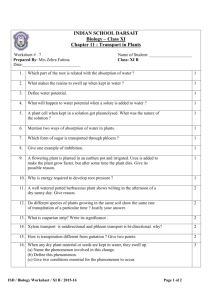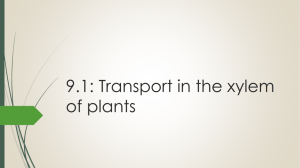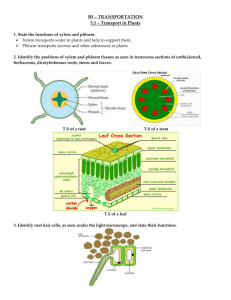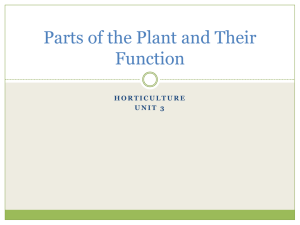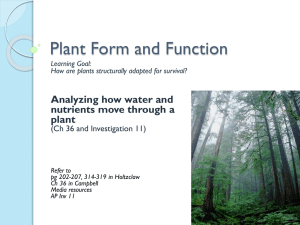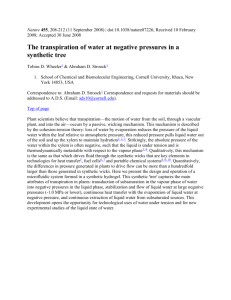6. Structure and transport in plants
advertisement
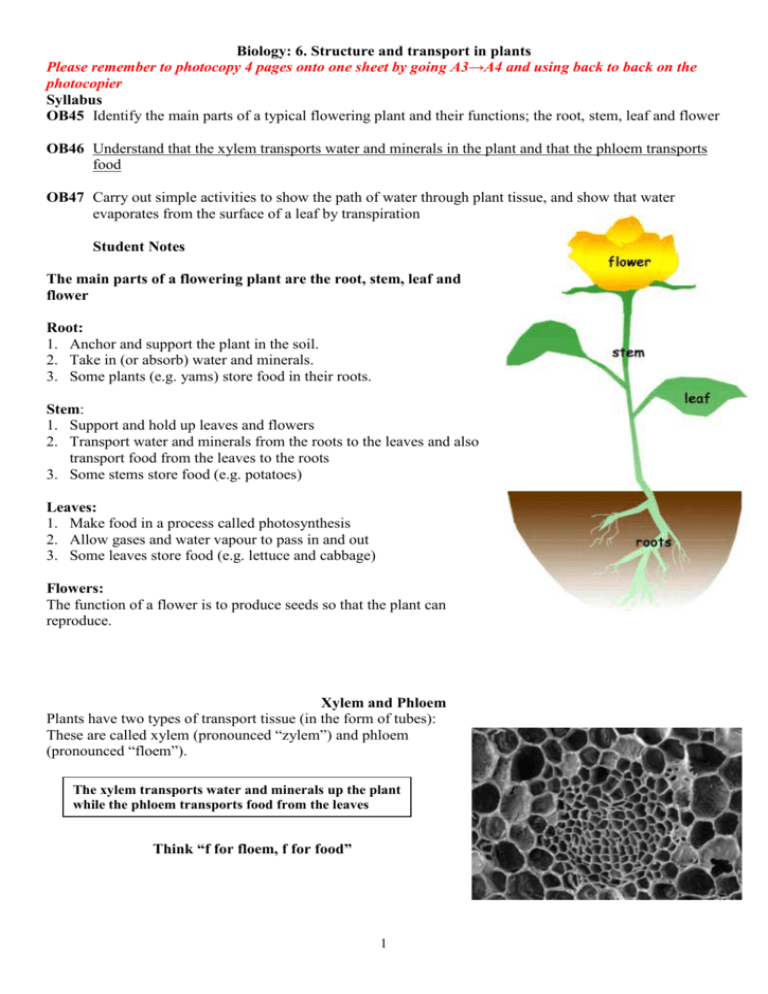
Biology: 6. Structure and transport in plants Please remember to photocopy 4 pages onto one sheet by going A3→A4 and using back to back on the photocopier Syllabus OB45 Identify the main parts of a typical flowering plant and their functions; the root, stem, leaf and flower OB46 Understand that the xylem transports water and minerals in the plant and that the phloem transports food OB47 Carry out simple activities to show the path of water through plant tissue, and show that water evaporates from the surface of a leaf by transpiration Student Notes The main parts of a flowering plant are the root, stem, leaf and flower Root: 1. Anchor and support the plant in the soil. 2. Take in (or absorb) water and minerals. 3. Some plants (e.g. yams) store food in their roots. Stem: 1. Support and hold up leaves and flowers 2. Transport water and minerals from the roots to the leaves and also transport food from the leaves to the roots 3. Some stems store food (e.g. potatoes) Leaves: 1. Make food in a process called photosynthesis 2. Allow gases and water vapour to pass in and out 3. Some leaves store food (e.g. lettuce and cabbage) Flowers: The function of a flower is to produce seeds so that the plant can reproduce. Xylem and Phloem Plants have two types of transport tissue (in the form of tubes): These are called xylem (pronounced “zylem”) and phloem (pronounced “floem”). The xylem transports water and minerals up the plant while the phloem transports food from the leaves Think “f for floem, f for food” 1 Water Transport Water is carried in tiny tubes throughout a plant. These tubes allow a continuous flow of water from the roots to the leaves of a plant. The tiny tubes appear as the veins in a leaf. To show that roots absorb water Set up as shown Leave for a week (the oil prevents water loss from evaporation). The level of water will have dropped in the tube. To show the movement of water in plants Place a stalk of celery with leaves attached into a beaker of water (which has food colouring to make it visible). After a few days the top of the stalk and leaves go red, showing that water rises up the plant. Transpiration Transpiration is the loss of water vapour from a plant Tiny openings (called stomata) on the lower surfaces of leaves allow water to evaporate from leaves into the air. This loss of water is called transpiration. Transpiration supplies water to the leaves for photosynthesis. Transpiration helps to cool plants (in the same way sweating helps cool the human body). To show that water evaporates from the surface of a leaf by transpiration Place a dry plastic bag around the upper part of a plant as shown. After a few hours a liquid will have formed on the inside of the bag. Test using anhydrous copper sulphate It will turn from blue to pink indicating that the liquid is water. Factors that increase rate of transpiration Sunlight, wind, soil water and low humidity Note: Food storage organs of some vegetables (carrots, beets, and radishes) are actually a combination of root and stem tissues. 2 Exam Questions 1. [2008 OL][2012 OL] Name the parts of the plant labelled X and Y in the diagram. 2. [2008][2012] Phloem and xylem are plant transport tissues. Name a substance, other than water, that is transported in (i) phloem and (ii) xylem. 3. [2010 OL] A white flower was placed in coloured water for a few days as shown in the diagram. (i) What effect would you expect this to have on the flower? (ii) What conclusion can be drawn about the movement of water in plants? 4. [2008 OL] Describe, with the help of a labelled diagram, how you would show the path of water upwards through a plant or a part of a plant. Use the following headings: Equipment, Procedure and Result. 5. [2006 OL] [2011 OL] The plant in the test tube drawn on the right was allowed stand in the laboratory for a few days to investigate the transport of water in the plant. (i) Which part of the plant takes in water? (ii) What would you notice about the level of water in the test tube after a few days? (iii) Why is it necessary to put oil on the surface of the water in the test tube? 6. [2006] Water vapour evaporates from cells in the leaves of plants and exits the leaves by way of tiny pores in their leaves. (i) What is this process called? (ii) How would you test the drops of liquid inside the plastic bag covering the shoot of the plant shown in the diagram to show that the drops are water? 3 7. [2011] Water vapour leaves plants through pores in their leaves into the atmosphere. (i) What is the loss of water by plants called? A pupil did an experiment to investigate this loss of water by plants. The apparatus that she used is shown in the diagram. The rate at which the water level fell (water loss) in the measuring cylinder was measured at regular intervals, first for a plant without the hair dryer (normal plant) and then for a plant with a hair dryer blowing warm air over the leaves (blown plant). The pupil used the data obtained to draw the graph below. (ii) Examine the graph and comment on the rate of water loss by the ‘normal plant’. (iii)What two factors were different for the ‘blown plant’? (iv) Name the tissue that transports water up the plant from roots to leaves. Exam Solutions 1. (i) X: Flower / petal (ii) Y: Stem 2. Phloem: food/ sugar/carbohydrate Xylem: minerals/ named mineral 3. (i) Coloured petals / flower becomes coloured (ii) Water travels up (through the flower stem) 4. Place a leafy plant in coloured water Leave for a time Leafy plant becomes coloured 5. (i) Roots (ii) Drops / lowers (iii) To prevent evaporation (to prevent water loss) 6. (i) Transpiration (ii) Water turns anhydrous copper sulphate blue/ blue cobalt chloride pink. 7. (i) Transpiration (ii) Steady/ even/ low/ little change… (iii)Moving air (wind) (iv) The temperature was greater (v) Xylem 4
